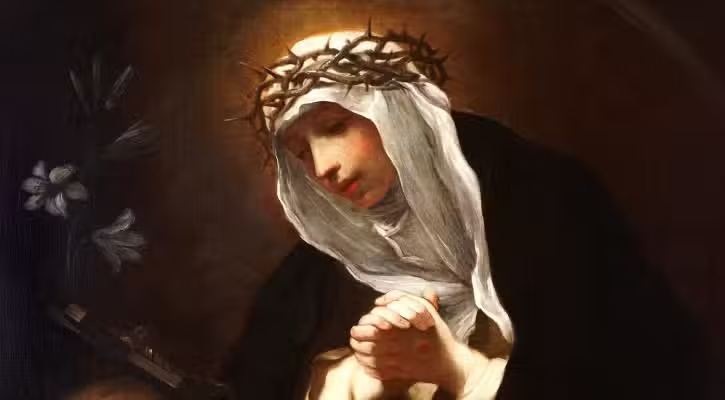Catherine Benincasa’s life is both thoroughly medieval and surprisingly modern. She became the “Mamma” of a band of friends and disciples, including some saints in their own right, such as Blessed Raymond of Capua. She was a nurse, a mystic, and one of the most influential women of her time. Through her letters and visits, she advised princes and popes on social and political issues, and is credited with ending the Avignon “captivity” of the papacy in the 14th century. She was a feisty Italian woman, one of the shining lights of the Dominican Order.
Catherine was canonized in 1461, a mere 81 years after she died. In 1939, as the Second World War was breaking out in Europe, she was named co-patron saint of Italy (with St. Francis of Assisi). And in 1970, at the start of the women’s liberation movement, she was declared a Doctor (exemplar and teacher) of the Church, one of the first women (with St. Teresa of Avila and later St. Thérèse of Lisieux) to be accorded that honor.
Catherine was born on another feast day, the Annunciation (March 25) in 1347. She was the 24th of 25 children (her twin sister died at three months), born to Lapa di Puccio di Piacenti, the daughter of a poet, and Giacomo di Benincasa, a prosperous wool dyer. The year after she was born, the plague descended upon Tuscany and the region was plunged into a severe economic depression. Walled, hilltop cities like Siena endured constant military and political struggles during these years.
As a child, Catherine was merry, playful and joyous, and her good humor stayed with her throughout her life. At age six or seven she had a mystical experience. Over the Dominican church in Siena she saw a regally dressed Jesus sitting on a throne, together with Saints Peter, Paul and John the Evangelist. Jesus had smiled upon her and held out his hand to bless her. She decided to vow herself to the service of God as a virgin, at a time when young women married to improve the financial or social status of their families.
She had to convince her parents that she did not want to marry (by cutting her golden brown hair) and endured their displeasure, which relegated her to servile duties within her family. Finally, her father allowed her a room at home for meditation and prayer. Here she began the austere fasting and ascetic practices that marked the rest of her life.
Catherine sought spiritual direction from the Dominican friars. She also endured long periods of feeling abandoned by God. She reportedly once prayed, “O Lord, where were you when my heart was so vexed with foul and hateful temptations?” A voice answered her, saying, “Daughter, I was in your heart, fortifying you by grace.” At the age of 20, while praying in her room, she saw herself being “mystically espoused” to Jesus, who gave her a ring only she could see.
After three years she was allowed to leave her family home and physically live with the Mantellate. These women (mostly widows) devoted themselves to charitable work among the poor in town and followed the Third Order Rule of St. Dominic. From age 21 until her death at 33, she nursed in the primitive hospitals, distributed alms to the poor and visited prisoners.
She attracted followers (Caterinati) and wrote copious letters to her spiritual “family.” Until the last three years of her life, she didn’t even know how to read or write, as was often the case for women in the 14th century. But she dictated hundreds of letters. Her letters grew to encompass popes and princes, priests and soldiers, religious men and women. More than 400 of her letters still exist.
At one point, however, Catherine was denounced as a fake and summoned to a General Chapter of Dominicans to answer charges of hypocrisy and presumption. All were disproved.
Like St. Francis of Assisi, Catherine received the stigmata (the wounds of Christ). While praying in front of a crucifix in a church in Pisa in 1375, she received these signs of her identification with Jesus’ suffering and fainted from the pain. The wounds of Christ remained invisible to others until after her death when all could see them.
In 1376, Catherine went to Avignon to make peace between the people of Florence and Pope Gregory XI, but failed. She did succeed, however, in ending the 74-year-long papacy in Avignon by convincing the pope to return to Rome.
Returning to Siena, she wrote her great spiritual classic The Dialogue, an account of her conversations with God. She calls God “first Gentle Truth” and the “essence of Charity,” a God in love with humanity. She regards Jesus as the bridge between heaven and earth, “a lifeboat to draw the soul out of the tempestuous sea to conduct her to the port of salvation.”
When a rival pope was set up in 1378, initiating the Great Schism, Catherine wrote letter after letter asking European princes to recognize Urban VI in Rome as pope. She also wrote Urban to bolster him in his trials. The pope eventually told her to come to Rome that he might have her advice close at hand.
But she died soon afterward of a stroke in Rome in 1380. She said she was offering herself to God as a victim for the pope and Church unity. The Great Schism did not end until 1415.
St. Catherine of Siena lived during the end of the Middle Ages and beginning of the Renaissance. It was a time of change and uncertainty—like today. Catherine had her enemies and even survived assassination attempts. But she preached a message of peace and forgiveness. Her message is one of hope, especially for our Church.









3 thoughts on “St. Catherine of Siena: The Feisty Dominican”
Pingback: Saint Catherine of Siena – Saint Gregory the Great Catholic Church
I adore her piety and her works. Hope I could be like her. But first of all I must learn to love. This I ask of her to plead to the Lord to give me love, compasion and mercy to my neigbors.
How I dare to add to her message, when I’m nothing compared to her. Her messages are fully relevant to day and tomorrow.